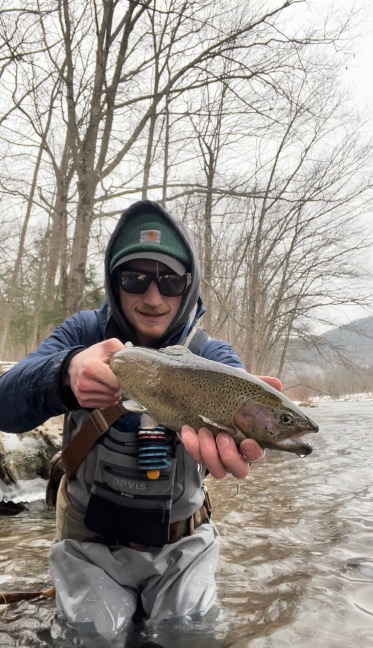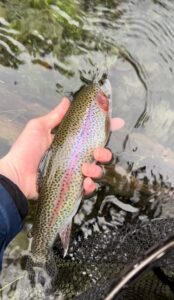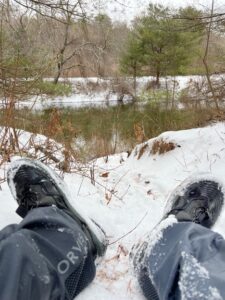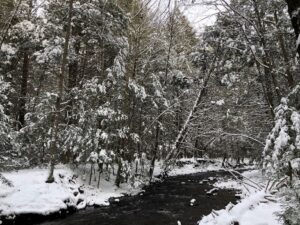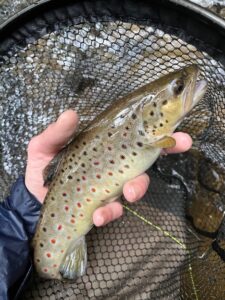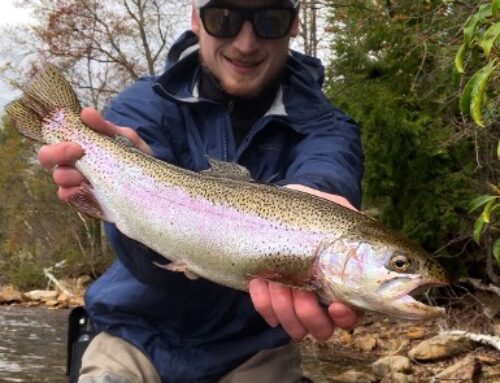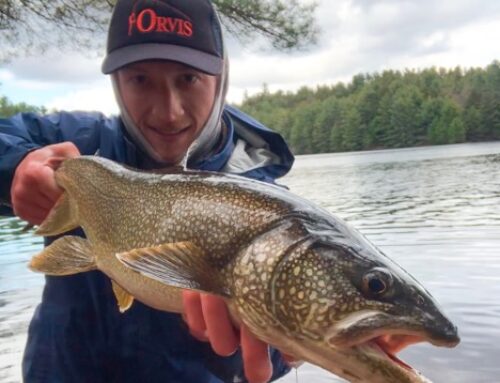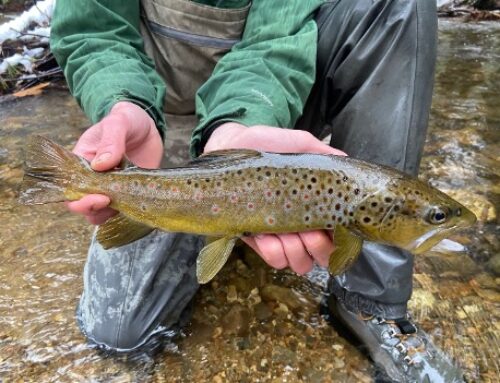Well, the good news is that the days are getting incrementally longer…the not so good news is that we are still facing the brunt of winter conditions. Options are a bit limited at the moment, but there’s still some bites to be had out there.
On the Fife Brook stretch of the Deerfield, flows have been up and down in the past week with low points around 125 CFS and high marks just over 1000 CFS. Flows on the lower stretches have generally been higher, ranging from 800-1500 CFS. If you’re planning to fish lower down on the system, be wary of web forecasts as real time flows are not exactly in keeping with what’s being forecasted online.
No matter where you’re fishing on the D at the moment, ice and snow conditions should be a major consideration. Areas of significantly slower water (ex: the area around Crab Apple Whitewater) have been producing a lot of ice and should generally be avoided. One’s best option will be to fish higher up towards dams where turbulent water prevents such significant ice development. As a cursory safety reminder, remember to never walk out onto river ice as currents cause irregularities that are easy to miss. In areas of solid access, navigating the river’s banks should also be a major consideration. Recent snowfall has blanketed the river which obscures many hazards, perhaps the most significant of which are ice-encrusted rocks. It’s wise to avoid walking on the banks and stick to the woods as much possible, and also make sure to wear your studded soles for a little added protection when you must be moving over rocks. The Korkers OmniTrax system—which allows one to easily change out different types of boot soles—is great for such situations. Stop by the shop or give us a call to check out and/or learn more about our selection of Korkers boots and soles.
Additionally, be aware that parking access will be limited as most access points don’t get plowed. Take caution when parking in snow especially on the upper river where there is no cell service. Getting stuck will likely mean a long, cold walk back to Charlemont.
As far as approach goes on the Deerfield, nymphing tactics will reign supreme. Keep in mind that fish have transitioned into wintering patterns so make sure to focus attention on slower margin water, especially when wading. Stable structure like rock and wood along the banks create ideal current cuts that many fish will file into. Trout will almost always seek out the lowest effort, highest reward areas to operate in; a fact that’s doubly important in winter when their activity has slowed down dramatically. For wading anglers in higher flows, this may mean getting creative with casting and presentation as back-cast space can get pretty limited. On indicator rigs, water-loaded casts are a great trick to avoid hanging up in the trees. Roll casts can also be effective but can be difficult to execute especially with larger, firm-body indicators. When contact nymphing, pendulum casts are useful when your back is up against the trees.
For nymphing fly selection, the same concepts will remain true since we last reported. Keep in mind that bug activity is low in the winter and fish are often taking whatever random forage they can manage to get their mouths around without expending too much energy. Smaller stonefly nymphs (#14-18) have been more productive than larger imitations (like a Pats rubber legs) of late, however, that doesn’t mean bigger nymphs are off limits. Although not exactly a larval imitation, leech patterns have also been productive on both indicator and contact rigs. From the tying perspective, don’t be afraid to tie leeches with a hot-colored bead (orange has been best) for more of an egg sucking leech presentation, a pattern which can be particularly productive in higher water. While we’re on the subject of junky patterns, keep in mind that junk flies are an essential element in your winter box. Like it or not, eggs, worms, mops, leeches and the like just flat out get the job done in all seasons but especially in winter.
Aside from nymphing, streamer opportunities should not be counted out, especially in higher flows (600 CFS+). Not much has changed since we last reported as far as streamer opportunities go, so make sure to check out our January report for a bit more detail on the subject.
Below Quabbin on the Swift River, it’s pretty much business as usual for the winter. Flows have remained consistent, hovering around 45 CFS which will likely remain the case looking forward through the rest of winter and into spring. For now, remember that the Swift is fed from a deep tailwater so generally remains above the freezing level. You may come across some ice shelving but rarely is it significant enough to hamper opportunities. You might find some more significant ice down past Cady Lane where the river slows and deepens out, but the most popular stretches near Rt. 9 should be all but clear.
As far as approach goes, you guessed it, nymphing tactics will be king. A light (ideally yarn) indicator rig or a contact rig will perform well in the few areas of faster water where visibility becomes limited by surface texture, however, naked nymphing is a tactic that shouldn’t be overlooked especially where water is slow and visibility is high. If you’ve not naked nymphed before, the technique can be simply summed as throwing subsurface flies without any kind of strike indicator. In some rivers it can be necessary to keep contact with the rig or watch the tip of your fly line to detect bites, however in the Swift, you should be able to see takes given its gin clarity. The best way to start out with naked nymphing is likely by using highly visible flies like eggs or worms so you can track them by sight in the drift. As you improve, you can try your hand at presenting smaller, more hatch-matching imitations—usually midges in the dead of winter. This technique is often effective on the Swift and is a good tactic to take forward with you as spring approaches.
Lastly, keep eyes peeled for fish rising to midges, one of the Swift’s wintertime specialties. Dan Trela’s wicked pissah midge emerger—a locally-tied version of which we carry in the shop—is a time-tested classic for converting cold weather risers. This is an absolutely miniscule fly that often demands using tippets as light as 8x in order to avoid drag. It’s also easy to lose sight of the wicked pissah so consider dropping it off a small but more visible lead fly such as a small parachute or hi-vis Griffith’s gnat. When in doubt, hook sets are free so if you see something rise in the vicinity of your rig, don’t be afraid to give it a yank.
(Kevin offers his top tips for winter fishing on the Swift in more detail on our most recent blog post here.)
As for the Millers and Westfield Rivers, the unfortunate reality is that ice conditions have locked both systems up significantly. You might find a few areas of clear water to run a drift through but expect treacherous conditions both on the shore and in the water. Again, even if ice seems solid enough to take your weight, never walk out onto river ice. This being said, neither the Millers nor the Westfield would be the first places we’d send you at the moment.
The same can also be said for the vast majority of local small water. At this point, most creeks are all but completely frozen over and covered by snow with significant anchor ice (slushy mounds of ice that grow upwards from the bottom as ice crystals stick to rocks and then each other) as well. You might find some openings in the ice around plunges and the like but expect that presentation will be extremely difficult if not impossible altogether. Also consider that creek fish are having a rough go of it as they do what they can to survive the winter, and that angling pressure is sort of the last thing they need right now. Yet again, the creeks are not the first place we’d send you right now.
Outside the world of trout, there isn’t much to report. You’d be hard pressed to find a single opportunity in still water as the lion’s share if not all local options are bound up in ice at the moment. Rivers which support populations other than trout are a similar story. Ice conditions on the Housatonic will make for extremely limited options if any at all. The Connecticut, although largely unfrozen, is a bit of a wasteland at this time of year as most fish either seek out the river’s most significant depth or shelter in the terminal stretches of abutting tributaries where ice conditions and general access are unviable. We hate to say it for a third time, but these fisheries are just not at the top of the list right now.
Off the water, Bugs & Beers season is in full swing. We’re hosting two sessions each month; the first is on the first Thursday of the month at Dirt Church Brewing Co. in Charlemont, the second on the third Thursday of the month at Progression Brewing Co. in Northampton. The Dirt Church sessions are free to join and are completely free-form—no tying theme or specific flies, just bring in materials and tools for whatever you’d like to spin up. That said, let us know if you want to work on something particular ahead of time and we can try to bring materials for a specific pattern or technique. This is also a great session for more novice tyers and if requested in advance we can bring materials, vise and tools for folks. The Progression sessions are more typical to what we’ve done in the past with a tying theme and specific flies. These sessions include a $10 cover fee which will set you up with all the materials necessary for the session. The pace here is a bit faster and geared more toward intermediate and advanced tyers.
In addition to Bugs & Beers, remember that drop-in fly tying will be happening every Saturday at 10:30am at the shop. All are welcome to join, just bring along vise, materials and tools for whatever you’d like to tie—and of course the shop will be open for any purchases you need to make.
We’ll also be holding a new class on March 4th called Beyond the Bugger. This session is geared towards those with some initial experience (like our free Fly Tying Introduction class) and will go beyond the very basics and introduce students to some slightly more advanced techniques and fly patterns as they begin their fly tying journey. The class costs $20 and includes instruction and materials for all flies tied. Equipment can also be provided if arranged ahead of time. As a bonus, this fee will also include a $20 gift certificate to the shop so basically the class is free! Make sure to reach out with any questions.
We are starting to get our spring fishing clinic schedule together. Our first confirmed event is our annual Women’s Clinic with Cynthia Harkness of Fearless Fly Fishing. This ladies-only event is one of our most popular, and fun, offerings each year. Friday consists of land-based instruction in casting and the rudimentaries of fishing with a fly rod. Saturday we take to the water for a half day float on local waters with our seasoned guides where you have an opportunity to hone your newfound skills. The clinic takes place May 2-3, 2025 and costs $375. Call the shop or email brian@deerfieldflyshop.com for more info or to register.
As always, thank you for your continued support from all of us at the Deerfield Fly Shop. We wish you luck next time you’re out and hope to see you in the shop soon.

